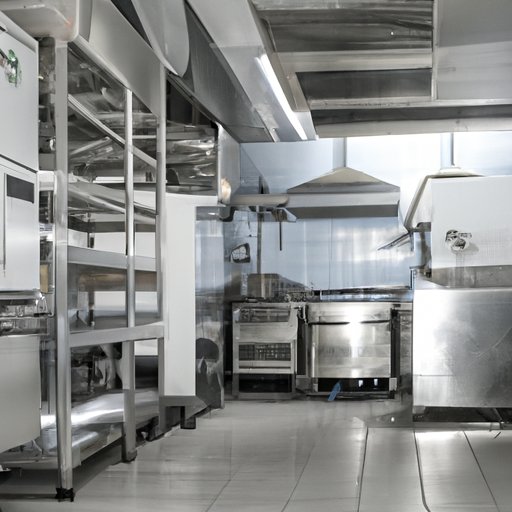Overview of a Commercial Kitchen: What Equipment is Necessary for Success?
A commercial kitchen is a space dedicated to food preparation and storage in a restaurant, catering business, or other food service establishment. It is typically separate from the dining area and must meet certain standards set by local health codes and regulations. In order to operate safely and efficiently, a commercial kitchen needs to be properly outfitted with the right equipment and have well-designed layout.
Definition of a Commercial Kitchen
A commercial kitchen is any kitchen that is used to prepare food for consumption by the public. This includes restaurants, caterers, cafeterias, bakeries, hotels, hospitals, and other foodservice establishments. A commercial kitchen must meet certain health and safety requirements in order to ensure food safety and quality. These include proper ventilation, adequate lighting, non-slip flooring, and the use of appropriate cleaning materials.

Types of Equipment Needed for a Commercial Kitchen
In order to run a successful commercial kitchen, you need to have the right equipment. This includes large appliances such as ovens, stoves, grills, fryers, and refrigerators, as well as smaller items like blenders, mixers, food processors, and ice machines. Other important pieces of equipment include sinks, shelving, storage containers, and worktables. You may also need specialized tools such as slicers, dicers, and grinders.

Other Considerations when Designing a Commercial Kitchen
When designing a commercial kitchen, it’s important to consider factors such as workflow, safety, and efficiency. Workflow is key to ensuring that your kitchen runs smoothly and that tasks are completed quickly and efficiently. Additionally, you want to make sure your kitchen is designed for optimal safety. This means having proper ventilation, non-slip floors, and the correct placement of electrical and gas lines. Finally, you want to make sure your kitchen is designed for maximum efficiency. This means finding ways to streamline processes and reduce waste.
An In-Depth Look at the Design of a Commercial Kitchen
Having a professional kitchen layout is essential for any commercial kitchen. A well-designed kitchen should take into account factors such as workflow, safety, and efficiency. It should also be tailored to the needs of the establishment, taking into account the type of cuisine served and the size of the kitchen staff. When selecting appliances and fixtures, it’s important to choose high-quality products that will stand up to the rigors of a commercial kitchen.
Benefits of Having a Professional Kitchen Layout
Having a professionally designed kitchen layout can provide many benefits, including improved efficiency and safety. By having a well-designed layout, you can ensure that tasks are completed more quickly and with fewer errors. Additionally, having a layout that follows safety protocols can help prevent accidents and injuries. Having a professional kitchen layout can also help improve customer satisfaction by providing a more pleasant atmosphere.
How to Choose the Right Appliances and Fixtures
When choosing appliances and fixtures for your commercial kitchen, it’s important to select high-quality products that will stand up to the rigors of a commercial kitchen. Consider the type of cuisine you’ll be serving and the needs of your kitchen staff. Additionally, look for energy-efficient products that will help reduce operating costs. Finally, make sure all appliances and fixtures are NSF-certified to ensure they meet safety standards.
Tips for Designing an Efficient and Safe Kitchen
When designing a commercial kitchen, it’s important to consider factors such as workflow, safety, and efficiency. To maximize efficiency, consider how tasks will flow from one station to another. Additionally, make sure all appliances and fixtures are placed in accordance with safety protocols. Finally, look for ways to streamline processes, such as investing in automation solutions.
Exploring the Benefits of a Commercial Kitchen
Having a commercial kitchen can provide many benefits, including increased efficiency and profitability, improved safety standards, enhanced customer satisfaction, and lower maintenance costs. By having the right equipment and a well-designed layout, you can ensure that tasks are completed quickly and safely. Additionally, having a professional kitchen can help create a positive impression on customers and increase their satisfaction.

Tips on Setting Up and Maintaining a Commercial Kitchen
Setting up and maintaining a commercial kitchen requires careful planning and execution. Before you begin, develop a plan that outlines your goals and the steps you need to take to achieve them. Next, purchase the necessary equipment and make sure it meets safety standards. Finally, establish proper cleaning and sanitization procedures to ensure a safe and healthy environment for your staff and customers.

The Different Types of Commercial Kitchens
Commercial kitchens come in many shapes and sizes depending on the type of establishment. Full-service restaurant kitchens are typically larger and more complex than those found in catering or concession stand operations. Hotel and hospitality kitchens may require specialized equipment such as dishwashers and ice makers. No matter the type of kitchen, there are certain elements that all commercial kitchens must have in order to operate safely and efficiently.

The Cost of Running a Commercial Kitchen
The cost of running a commercial kitchen can vary greatly depending on the size and scope of the operation. Initial setup costs can be quite high, as you’ll need to purchase all the necessary equipment and supplies. Ongoing operating costs can also add up, including utilities, labor, and maintenance. However, investing in technology can help reduce costs, such as using automated systems to streamline processes.
How to Optimize Your Commercial Kitchen for Maximum Efficiency
To ensure your commercial kitchen operates at peak efficiency, there are several steps you can take. Utilizing space effectively is key, so invest in adjustable shelves and racks to maximize storage. Investing in quality equipment is also important, as low-quality products can lead to higher maintenance costs and decreased efficiency. Streamlining processes and implementing automation solutions can also help reduce costs and increase efficiency.


